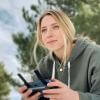Acoustic sensors enable efficient and non-invasive monitoring of a wide range of species, including many that are difficult to monitor in other ways. Although they were initially limited in application scope largely due to cost and hardware constraints, the development of low-cost, open-source models like the Audiomoth in recent years has increased access immensely and opened up new avenues of research. For example, some teams are using them to identify illicit human activities through the detection of associated sounds, like gunshots, vehicles, or chainsaws (e.g. OpenEars).
With this relatively novel dimension of wildlife monitoring rapidly advancing in both marine and terrestrial systems, it is crucial that we identify and share information about the utility and constraints of these sensors to inform efforts. A recent study identified advancements in hardware and machine learning applications, as well as early development of acoustic biodiversity indicators, as factors facilitating progress in the field. In terms of limitations, the authors highlight insufficient reference sound libraries, a lack of open-source audio processing tools, and a need for standardization of survey and analysis protocols. They also stress the importance of collaboration in moving forward, which is precisely what this group will aim to facilitate.
If you're new to acoustic monitoring and want to get up to speed on the basics, check out these beginner's resources and conversations from across the WILDLABS platform:
Three Resources for Beginners:
- Listening to Nature: The Emerging Field of Bioacoustics, Adam Welz
- Ecoacoustics and Biodiversity Monitoring, RSEC Journal
- Monitoring Ecosystems through Sound: The Present and Future of Passive Acoustics, Ella Browning and Rory Gibb
Three Forum Threads for Beginners:
- AudioMoth user guide | Tessa Rhinehart
- Audiomoth and Natterjack Monitoring (UK) | Stuart Newson
- Help with analysing bat recordings from Audiomoth | Carlos Abrahams
Three Tutorials for Beginners:
- "How do I perform automated recordings of bird assemblages?" | Carlos Abrahams, Tech Tutors
- "How do I scale up acoustic surveys with Audiomoths and automated processing?" | Tessa Rhinehart, Tech Tutors
- Acoustic Monitoring | David Watson, Ruby Lee, Andy Hill, and Dimitri Ponirakis, Virtual Meetups
Want to know more about acoustic monitoring and learn from experts in the WILDLABS community? Jump into the discussion in our Acoustic Monitoring group!
Header image: Carly Batist


- 0 Resources
- 14 Discussions
- 3 Groups
- 0 Resources
- 0 Discussions
- 4 Groups
- @laurenharrell
- | she/her/they/them
Data scientist/statistician working in bioacoustics and species distribution models, loves whales

- 0 Resources
- 0 Discussions
- 3 Groups
A Wildlife Biologist interested in Environment Assessment and Restoration, In-situ and Ex-situ strategies, Technologies used in Conservation and Illegal Wildlife Trade.
- 0 Resources
- 5 Discussions
- 13 Groups
- @Jackeline
- | She
- 0 Resources
- 0 Discussions
- 7 Groups
- @owenmartin22
- | He/Him
I am a firefly researcher and wildlife painter based in Boulder, Colorado
- 0 Resources
- 0 Discussions
- 4 Groups
- @Markbowler
- | He/Him
University of Suffolk
Wildlife distributions and the effects that human activity has on populations. Spatial ecology of Amazonian mammals through audio and camera surveys. Hunter and gun tracking in Peru. Bats in suburban and agricultural landscapes in the UK
- 0 Resources
- 1 Discussions
- 9 Groups
A wildlife scientist, focusing mainly in primates conservation & research, Community-based conservation and ecosystems management.
- 0 Resources
- 0 Discussions
- 6 Groups
Texas A&M University
- 1 Resources
- 3 Discussions
- 2 Groups
- @RHugtenburg
- | He/They
Student at Aberystwyth University. Bug Fanatic🪲. Worked at Octophin Digital for my industrial year placement 🐙.
- 0 Resources
- 0 Discussions
- 20 Groups
- @CynthiaGw
- | Her/she
Hi, Cynthia Gichimu here. I'm a conservationist, and a champion for youths. I believe in environmental sustainability for posterity. I volunteer as a Project Officer with the Friends of Kinangop Plateau, a community-based local action group committed to biodiversity conservation.
- 1 Resources
- 2 Discussions
- 6 Groups
Ramiro is an ecologist whose research interests are in the fields of applied animal ecology and conservation biology. He addresses critical research questions by integrating a combination of field data collection, GIS, remote sensing, and advanced modelling techniques.
- 0 Resources
- 0 Discussions
- 7 Groups
June 2024
July 2024
event
September 2024
event
November 2022
event
event
event
October 2022
event
42 Products
Recently updated products
Meet the WILDLABS TECH HUB Winners
13 May 2019 12:00am
Bird Bioacoustics - Good Practice Guidance
11 April 2019 9:42pm
WILDLABS Virtual Meetup: Low Cost, Open-Source Solutions
18 March 2019 12:00am
AudioMoth 2.0 Development
17 March 2019 2:44am
AudioMoth user guide
27 February 2019 9:35pm
14 March 2019 1:52pm
Hi again,
I agree; it's very important that everyone is able to contribute to the guide. Thanks for taking the lead on that, Akiba. To that end, I just made my GitHub repo publicly editable, so please feel free to add to it if you want to use a GitHub repository.
However, a Google Doc would be much easier for the general public to contribute to. If you choose that route instead, please use whatever you want from my repository. :-)
I personally like to use the guide as a single document instead of a Wiki. It's easier to read through, and since everything is on the same page, you can just CTRL+F to find a specific word or section. Also, it's helpful to be able to download it as a .pdf, or print it out and refer to it in the field.
Tessa
14 March 2019 3:43pm
Hi Tessa.
Thanks and also thanks for being so generous with your work :)
Regarding the format, how do you all think if we have a single document and a wiki? I could handle the single document if David wanted to do the wiki. One potential issue would be synchronization, but since many wikis keep a change list, perhaps we can schedule periodic document updates based on the wiki changelists. We can also maintain a document changelist in case the changes need to go in the other direction.
Any comments or suggestions?
Akiba
Advice for an in-situ Audio-Visual system for recording at a nest site
9 February 2019 6:19pm
25 February 2019 6:37pm
Hello Carlos and Sam
That book on "CCTV for Wildlife Monitoring" looks excellent. Although it is somewhat off at a tangent of my actual work this looks way too useful not to have. There are cheaper second-hand copies on Abebooks and eBay and also on sale at NHBS, £20.98 incl. UK P&P (https://www.nhbs.com/cctv-for-wildlife-monitoring-book).
An interesting interview with the author, Susan Young: https://blog.nhbs.com/author-interviews/interview/cctv-for-wildlife-monitoring-an-interview-with-susan-young/
Meanwhile, I have come across a research project by the author of that book using technology that looks very close to what Sam is trying to do: "CCTV Enables the Discovery of New Barbastelle Vocalisations and Activity Patterns Near a Roost - We monitored a barbastelle maternity roost for four months using a portable CCTV system, time synchronised with ultrasound recorders."
See more here: https://www.researchgate.net/project/Using-CCTV-to-link-vocal-repertoire-with-behaviour-in-bats
If the above does not do it, I think you should contact the author and get her advice on what would be a suitable setup for you. That's what I meant in my earlier post about maximising use of previously developed solutions. It will just save you a lot of messing about, especially if you are not a technical expert yourself.
I hope this is of some use. Do post an update when you have worked out what equipment to use.
Good luck,
Joachim Neff
6 March 2019 7:42pm
Hello Sam
I have now received the book on "CCTV for Wildlife Monitoring" (see my earlier post for more details) and it is as excellent as it looked online. If you can spare £21 then I would suggest you get a copy yourself.
The book is written for those without much technical background and the case studies are very detailed with equipment lists and setup details. I have not read the entire book but as far as I can see there are no examples described specifically with synced audio. However, all the case studies and detailed comments on what to watch out for (pun intended) should give you a lot of help in working out what you need for your project.
Good luck,
Joachim
8 March 2019 2:44pm
Joachim and Carlos,
Thank you both very much for all your help so far with this problem, all of your input is very constructive. I have had look into the CCTV tech and also that researchgate link, and both have provided me with a few more options. At the moment I am organising a visit to one of the "hackerspaces" near me, to see if anyone can give me some hands-on practical advice, mainly about a suitable power supply solution (as lots of inputs running and recording continuously will reduce the time it can be in-field substantially based upon a standard, small size power supply, as I understand it). I will let you both know when I have managed to develop a prototype, but this may take a month or two as I need to first order a starter kit for Raspberry Pi or Arduino, get my head around the basics, and also contend with my other work. I will be sure to let you all know if I make any headway!
Best wishes,
Sam
#Tech4Wildlife Photo Challenge: Our Favourites from 2019
3 March 2019 12:00am
Real-time audio monitoring
19 February 2019 10:42am
22 February 2019 2:33pm
Hi,
What you're asking, is it conceptually like turning on the mic on your PC and doing something with the output from the sound card? Instead of digitising the sound it's possible to do some kind of monitoring in the analogue domain. It sounds like an interesting problem, tell me more!
Thanks.
1 March 2019 8:17am
What frequecy are you looking to record, how long does the mic need to run for, what is the distance between the microphone and the "listening" site? As (unless I've missed something) an off the shelf radio microphone does exactly that job.
Bioacoustics for Ecologists: Hardware, Survey Design and Data Analysis
 PR Statistics
PR Statistics
25 February 2019 12:00am
AudioMoth - Big data software?
26 September 2018 12:02pm
24 October 2018 5:55pm
AH, okay. Yes, if something goes wrong writing to the SD card during a recording, the file won't be closed, and so the file size won't be updated. Let us know if you get any zero length files in †he future since it shouldn't happend. We have another release of the firmware and configuration app coming out in a couple of weeks that makes the routine which writes to the SD card a bit more robust if something goes wrong, uses human readible long file names, and also adds local time to both the configuration app and the resulting time stamps. Alex
21 December 2018 10:55pm
Hi David,
Kate Jones suggested trying our their Bat Classifier tool - deep learning tools for bat acoustic signal detection. We've quite a few members here who worked on it if you've got questions (@Rory_Gibb, @snewson, @robin_freeman as a start)
We have a method for finding bat calls that is super quick, free and all code is open source https://t.co/52FPZHLyQU
— Kate Jones (@ProfKateJones) December 21, 2018
Steph
22 February 2019 1:28pm
How about using Kaleidoscope and the cluster analysis tool? Works fine, and is super-quick..
Ta, Carlos
UK Southwest bat conference
15 January 2019 9:21am
22 February 2019 12:43pm
I'll be there - on the Wildlife Acoustics stand...
Please come and say hi!
Carlos
AudioMoth v1.1 is now available
23 January 2019 12:37pm
6 February 2019 3:58pm
Quick update
This audiomoth group purchase is now 581% funded. To meet with demand and component stock, if they reach 1500 devices they will close this round early and start to manufacture. A new round additional round will be opened at the same time in this eventuality.
As of this morning, this means htere are 338 devices left if you want to be included in this manufacturing run of the updated Audiomoth (v1.1).
18 February 2019 5:15pm
Update
The current AudioMoth group purchase reached our stock level of 1550 devices, hence the campaign has closed early. We'll now set up the manufacturing run and update you shortly on our progress.
Postulates of Soundscape Ecology
18 February 2019 9:35am
Can anyone recommend speakers for playback of primate calls?
10 February 2019 9:01pm
SODA Suite -An endeavour to assimilate global soundscapes on a cloud platform.
2 February 2019 6:09am
4 February 2019 4:01pm
Thanks! We also just posted info on the AVISONA 2019 event to the resources page for anyone who missed it and wants to learn more.
Getting up close and personal with Antarctica's orcas
 Jamie Morton
Jamie Morton
4 February 2019 12:00am
Avisona 2019: Workshop on Bird Call Recording and Analysis
24 January 2019 12:00am
Recording problems with Audiomoths
30 December 2018 9:57am
2 January 2019 3:00am
Hi David
Thank you for your answer. I'm using 2000mAh Fujitsu R06 batteries. When configuring the AudioMoths, daily energy consumption is said to be 72mAh. The batteries should last for at least 20 days. I've never had them deployed for more than seven days straight (and they even did the zero lenght files at deployment for only three days). Maybe the energy consumption calculator in the configuration program is faulty?
Where can I find the firmware?
Alex
2 January 2019 7:49am
Information and links to the new firmware and the app is here https://www.openacousticdevices.info/single-post/2018/12/12/Version-120---New-Firmware-and-Config-App-Now-Available. Note: there is a possiblilty of the update failing and the recovery proceedure is here https://www.openacousticdevices.info/support/device-support/device-bricked-during-firmware-update.
With batteries it is also to do with voltage decay as well as power. There was a discussion Nov 2017 about voltage limits and it was said that SD cards get a bit twitchy at less than 3.3v but the rest will still be operating at around 3v - I can't find any data on R06 however in general voltage drop is influenced by temperature, dicharge rate, age/no of recharges etc etc - your are right it may not the batteries but there is a possibility it might hence my suggestion.
I'd suggest also posting on the AudioMoth support forum, to see if anyone else has seen this issue and has a fix.
Cheers
David B
2 January 2019 10:01am
Forgot to say - if you are having trouble reformatting SDcards on Windows- the project suggests this programme http://www.ridgecrop.demon.co.uk/index.htm?guiformat.htm.
Machine learning to detect fish bomb blasts
20 December 2018 1:16pm
3D printed audiomoth cases
18 December 2018 10:14am
Introductory online training videos in bioacoustic analysis using Raven
5 December 2018 10:43am
Monitoring Ecosystems through Sound: The Present and Future of Passive Acoustics
 Ella Browning
Ella Browning
4 December 2018 12:00am
AudioMoth is now available on LabMaker
5 September 2018 5:17pm
How to share data on species to help conserve them… whilst avoiding them being exploited by poachers
 Ayesha Tulloch
Ayesha Tulloch
20 August 2018 12:00am
Ocean Hack: San Francisco, 10-11th September, 2018
 One Ocean Collab
One Ocean Collab
20 August 2018 12:00am
AudioMoth group purchase (round 5) is open now.
26 July 2018 3:43pm
7 August 2018 4:00pm
I love seeing how much this little device has taken off!
The 2018 Ecoacoustics Congress Wrap-up
 Anthony Truskinger
Anthony Truskinger
25 July 2018 12:00am
Audiomoth Group Purchase (Round 3)
5 February 2018 12:02pm
11 April 2018 5:26pm
Hi all,
Do to the success of Round 3 (hitting its target 15 days early and reaching the stock limit) we have started to explore the possibility of launching a 4th round, with a shorter time frame (probably 15 days) and with a limit of 250 devices. This will all come down to component stock, and finding it, so we'll update you next week (16th April) once we have confirmed it's possible.
Kind regards,
Alasdair
23 April 2018 5:36pm
Quick update from @alasdair - 'The 4th round of AudioMoth will go live Mon 30th April and there will be 250 made available. This has been made possible as we need to manufacture all those from round 3 and 4 at the same time whilst we await a stock re-order of a component.'
Alasdair has promised to post the time it goes live as it's bound to fill up quickly, given how fast the third round sold out. Stay tuned!
23 April 2018 5:53pm
Hi Stephanie, thanks for the update above. We will be doing two things this week to support the community. To meet the demand from Round 3 we require an essential component (MOSFET) and so we are planning to;
1) contact the 110 backers from this round (3) to ascertain how many have field trip deadlines and work with CircuitHub, the manufacturer, to see what's possible to meet deadlines - i.e identifiying other stockists of the missing component, or possibly an advanced run with the stock available now for those with an urgent deadline.
2) Launching a 4th Round on Monday 30th April with 250 devices available. This will have a shorter run time of 14 days and is possible as it will end shortly before the delivery of the stock needed to complete orders from both round 3 and 4, allowing us to help those who couldn't get in to round 3.
All the best,
Alasdair | Arribada Initiative
Conservation Technology User Guidelines Issue 4: Satellite remote sensing for conservation
 Paul Glover-Kapfer
Paul Glover-Kapfer
23 April 2018 12:00am
Listening to the Forest: WWF Fuller Seminar
27 March 2018 8:28pm






























14 March 2019 10:08am
That also sounds like a good idea :)